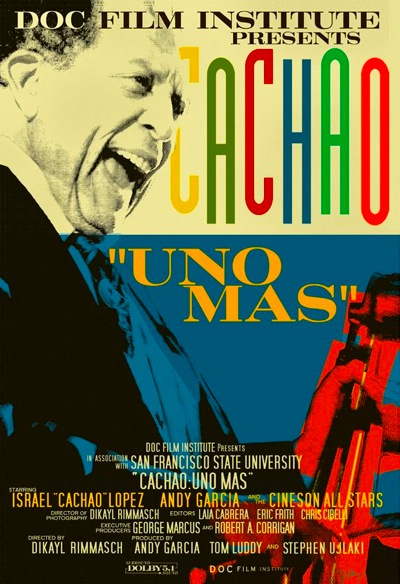By Joe Bendel. He played for Presidents FDR and W. In between, he revolutionized Latin dance music, endured the pain of exile from his Cuban homeland, and enjoyed a late-career renaissance thanks in large measure to the efforts of musician-actor Andy Garcia. His name was Israel López, but most knew him simply as Cachao. His life and insistently danceable music are lovingly remembered in Dikayl Rimmasch’s Cachao: Uno Mas, co-produced by Garcia, which airs today as part of the current season of PBS’s American Masters.
A classically trained bassist, Cachao co-wrote Mambo #1 with his brother Orestes. Simply titled “Mambo,” it was the first of his signature danzóns (Cuban ballroom dances), featuring jazz like syncopation and an infectious rhythmic drive. Needless to say, the mambo was a hit—everywhere—spawning the global mambo craze. Yet, Cachao usually was not the one in the spotlight. Hip musicians certainly knew who he was though.
 According to Cachao, he and his brother wrote 1,500 danzóns each. He also recorded his classic Descargas: Cuban Jam Sessions in Miniature, thoroughly blurring the distinctions between jazz and traditional Cuban musical forms. He even penned “Chanchullo,” the original melody that would become first Tito Puente’s and then Carlos Santana’s “Oye Como Va.” That Cachao never received proper credit or compensation for those monster hits still visibly rankles Garcia, but the zen-like master bassist was apparently unconcerned with such worldly matters.
According to Cachao, he and his brother wrote 1,500 danzóns each. He also recorded his classic Descargas: Cuban Jam Sessions in Miniature, thoroughly blurring the distinctions between jazz and traditional Cuban musical forms. He even penned “Chanchullo,” the original melody that would become first Tito Puente’s and then Carlos Santana’s “Oye Como Va.” That Cachao never received proper credit or compensation for those monster hits still visibly rankles Garcia, but the zen-like master bassist was apparently unconcerned with such worldly matters.
Unfortunately, worldly events would intrude into Cachao’s musical life. Though he initially supported the revolution against Battista, Cachao (like Garcia’s parents) chose the pain of exile as the oppressive nature of the Castro regime became painfully apparent. As the American Master himself explains: “Over there they say, ‘No, because of Fidel . . .’ and that’s it. Everyone is listening to you to hear what you say. If they don’t like it, you’re asking for trouble.”
Though Cachao passed away in early 2008, he was playing strong up until his final bar. Wisely, Uno Mas showcases his musical fire, fitting its profile segments around a scorching hot 2005 concert in San Francisco. Cachao swings like mad with an all-star ensemble including Garcia on bongos, John Santos on congas, Justo Almario on saxophone, and Federico Britos on violin (at one point engaging in some tasty call-and-response with the leader).
Utilizing nine cameras, Rimmasch shot some of the best live concert footage you are ever likely to see on television. He beautifully captures the unspoken back-and-forth between musicians, which probably gives a better sense of Cachao the man than any of the interview segments. Indeed, the music is so good, Uno Mas is probably destined to become a staple of PBS pledge break programming for years to come. While he does not perform in the film, trumpeter and Cuban defector Arturo Sandoval (played by Garcia in the under-appreciated HBO film For Love or Country) also adds some entertainingly animated musical commentary.
Cachao led a dramatic life and left behind an impressive body of absolutely joyous music. Like many Cuban exiles, he became a loyal patriot of two countries, making him a perfect subject for American Masters. Sometimes touching, but ultimately a blast of invigorating music, Uno Mas airs today (9/20) on PBS outlets nationwide.
Posted on September 20th, 2010 at 9:11am.
This looks fantastic. Cachao is terrific and I love the vintage footage of the dancing and performing! A lot of character, talent, and heart in his music. Thanks for letting us all know about this, you guys. It’s nice to have something to look forward to on TV